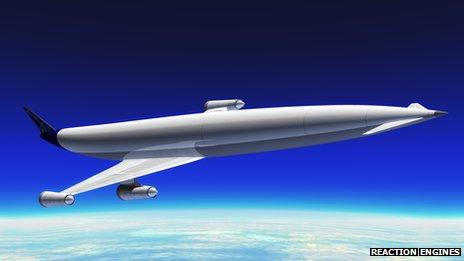Could hypersonic flight become a reality?
- Published

When Concorde was decommissioned in 2003, supersonic air travel became a thing of the past. But work has begun on a passenger aircraft that could go further and faster - flying from Europe to Australia in four hours. Will it ever become a reality?
The European Space Agency's goal is to create a hypersonic passenger plane, one that flies more than five times faster than the speed of sound and six times faster than a standard airliner.
It's not the first time hypersonic flight has been attempted. In 1960, tests took place on the X-15 - half plane, half missile - which carried one pilot and flew for 90 seconds before its rocket fuel burnt out.
Its creators thought it would herald a new era of high-speed civil aviation but more than 50 years later, a hypersonic passenger plane has yet to be tested or even built.
Now a team led by the European Space Agency, known as Lapcat, are working on an aircraft called the A2, which could take up where the X-15 left off.
The technology involved in exceeding the speed of sound - Mach 1 - is extremely complex.
"Mach number is the key," says aerodynamics expert at Imperial College London, Paul Bruce.
When you go below Mach 1, so flying slower than the speed of sound, and then go above Mach 1, the physics changes, he says.
"When you go to Mach 5 or 6 the laws start changing once again."
At hypersonic speeds, gases and metals behave very differently. Airliner engines that work at subsonic speeds - about Mach 0.85 or 913km per hour - won't work.

Neil Armstrong, the first man to set foot on the moon, once piloted the X-15
A plane that will fly five times faster than the speed of sound also needs an engine that can take off at subsonic, boost to supersonic and cruise at hypersonic speeds.
Another problem is heat. When air moves over the plane's outer surface at high speed, friction causes its temperature to rise very quickly - to over 1,000C, so the skin of the plane has to be built to withstand very high temperatures.
Engineers think they can overcome these problems, but it will take them decades to do so. The A2 is not expected to fly until 2040.
The ghost of Concorde also haunts the project. Concorde flew for 27 years but after an air crash investigation grounded it in 2000, its carriers British Airways and Air France realised they could generate more revenue by selling first and business class tickets on subsonic planes.
Tom Otley of Business Traveller magazine believes hypersonic flight could suffer the same fate because the demand for faster flights just isn't there.
"Speed isn't everything, comfort and cost play a big part. If you ask people how fast aircraft fly they wouldn't have a clue, they don't care but they do know which one is the most economical, which one is the most comfortable and which is the quietest."
Even business travellers are willing to take indirect flights in order to save money, a study found last year.
Reaction Engines, part of the Lapcat consortium, says the cost of hypersonic flight would match that of current business class travel - but sceptics say this presupposes the discovery of a new, much cheaper, way to produce the A2's liquid hydrogen fuel.
At present, to create enough hydrogen to fly 10 hypersonic planes from the UK to Australia every day would use up to 20% of the UK's national grid, according to one calculation. And in the European Union, airlines will from 2012 be obliged to pay for each unit of carbon used in the making of liquid hydrogen fuel.
Even if cheap liquid hydrogen does become available, aviation expert John Strickland questions whether high-speed flying will ever make sense for the airline industry - which traditionally subsidises economy seats with the profits made in business class.
"If you took those people off those subsonic flights then you throw into question the economics of those flights," he says.
"Somewhere along the line you would end up either cancelling the subsonic flights or struggling to get the right price levels even to make a hypersonic service financially viable."
The Europe to Australia route, he says, has a predominantly friends and family profile. And when British Airways tried to run Concorde to the Far East via Bahrain, the service proved unprofitable and was cancelled.
The A2 will not be able to fly to New York, the world's busiest business-class route, as the distance is too short for it to reach the necessary altitude.
So far, the Lapcat II project has received €10m (£8.33m) in funding from the European Commission and private investors. In 2013, that funding will run out and the project's viability will be reviewed before it can continue.
Project co-ordinator Johan Steelant is confident that the A2 concept will bear fruit.
"In 2013 we will be able to demonstrate that the critical technology is no longer a blocking point," he says. "But of course there are different systems and subsystems that still need to be proven."
The European Commission wants to be a pioneer, showing the way forward for aviation in the second half of the century, Mr Steelant says.
But John Strickland remains doubtful.
"It's a big scientific and technological ambition," he says. "But in this current climate when governments don't have enough money to deal with every day to day challenge they are certainly not going to put it into hypothetical projects to build a hypersonic airline."
To find out more about hypersonic flight listen to Discovery from the BBC World Service.